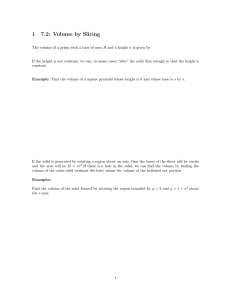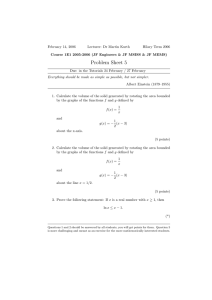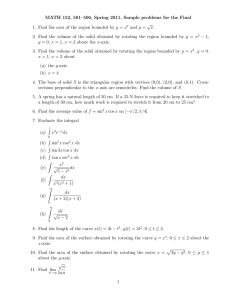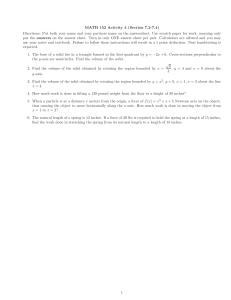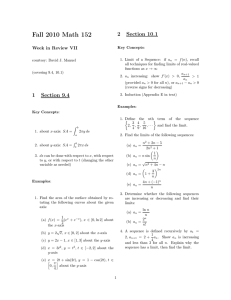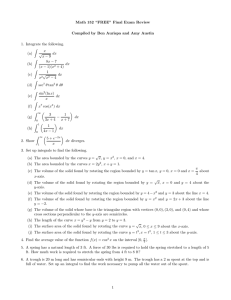Section 7.2– Volume
advertisement
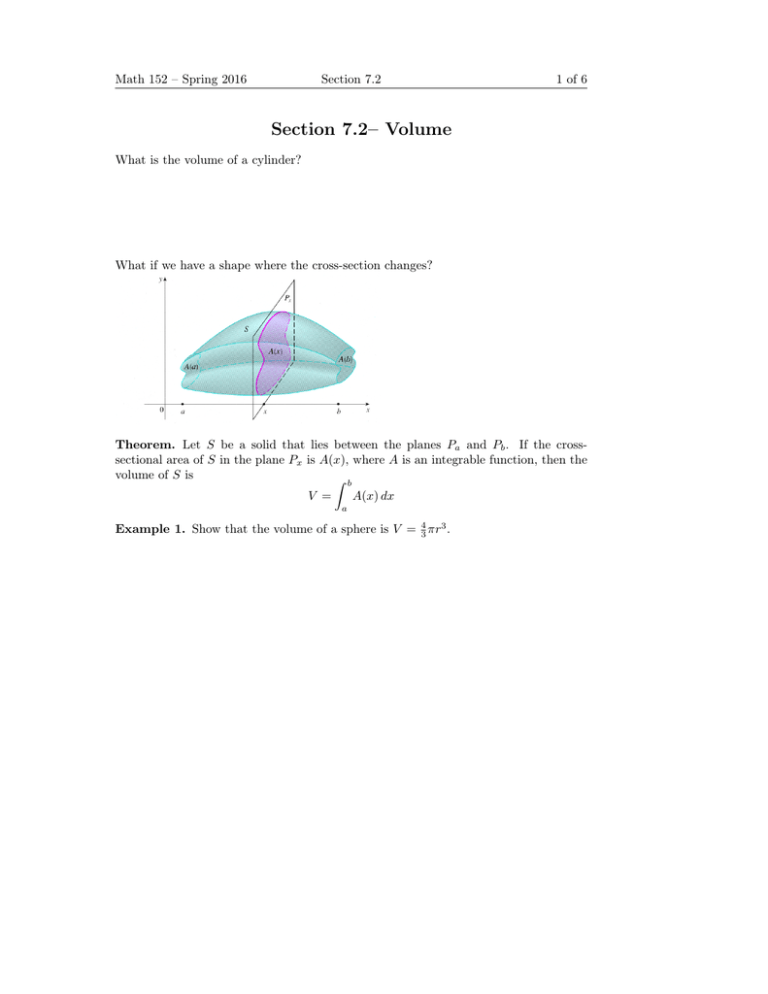
Math 152 – Spring 2016 Section 7.2 1 of 6 Section 7.2– Volume What is the volume of a cylinder? What if we have a shape where the cross-section changes? Theorem. Let S be a solid that lies between the planes Pa and Pb . If the crosssectional area of S in the plane Px is A(x), where A is an integrable function, then the volume of S is Z b V = A(x) dx a Example 1. Show that the volume of a sphere is V = 34 πr3 . Math 152 – Spring 2016 Section 7.2 2 of 6 Theorem. If the region bounded by the curves y = f (x), x = a, x = b, and the x-axis is revolved around the x-axis, then the volume of the resulting solid is b Z π[f (x)]2 dx V = a Remark. This is called the disk method since the cross-sections we are integrating are disks. Example 2. Find the √ volume of the solid obtained by rotating about the x-axis the region bounded by y x − 1, x = 2, x = 5, and y = 0. Remark. We can also rotate a region around the y-axis, but then we need to integrate along the y-axis with y as the variable. Theorem. If the region bounded by the curves x = g(y), y = c, y = d, and the y-axis is revolved around the y-axis, then the volume of the resulting solid is Z V = b π[g(y)]2 dy a Example 3. Find the volume of the solid obtained by rotating about the y-axis the region bounded by (y − 2)2 = x, x = 0, and y = 0. Math 152 – Spring 2016 Section 7.2 3 of 6 Example 4. Sketch the region bounded by the curves y = x2 and y = 4x. Find the volume when this region is rotated around the x-axis. Theorem. If the region bounded by y = f (x), y = g(x), x = a, and x = b is rotated around the x-axis (with f (x) ≤ g(x) on [a, b]), then the resulting solid has volume Z V =π b [f (x)]2 − [g(x)]2 dx a Remark. • This is called the washer method since the cross-sections look like washers (a disk with a hole cut in the middle). • If the rotation is not around the x- or y-axis, then you need to be careful to use the correct outer and inner radius for the washer. The formula above only works for rotating around the x- and y-axis. Example 5. Find the volume of the solid obtained by rotating the region bounded by √ y = x and y = x2 about the line x = 4. Math 152 – Spring 2016 Section 7.2 4 of 6 Example 6. Find the volume √ of the solid obtained by rotating around the line y = 1 the region bounded by y = 3 x and y = x2 graphed below. Non-Rotational Solids Example 7. Find the volume of the following solids. (a) The base of S is the triangular region with vertices (0, 0), (2, 0), and (0, 1). Crosssections perpendicular to the x-axis are semicircles. Math 152 – Spring 2016 Section 7.2 5 of 6 (b) The base of S is a circle with radius 2 and the cross-sections are equilateral triangles. (c) The base of S is the area enclosed by x = 1 − y 2 and the y-axis. Cross-sections perpendicular to the y-axis are isosceles triangles with height equal to the base. Math 152 – Spring 2016 Section 7.2 (d) The base of S is the region bounded by y = perpendicular to the x-axis are squares. 6 of 6 √ x and y = x2 . Cross-sections (e) Find the volume of a pyramid whose base is a square with side L and whose height is h.
